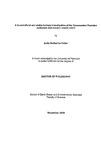Foraminiferal and stable isotope investigation of the Cenomanian-Turonian extinction and oceanic anoxic event
| dc.contributor.author | Fisher, Jodie Katherine | |
| dc.contributor.other | Faculty of Science and Engineering | en_US |
| dc.date.accessioned | 2011-05-13T13:58:40Z | |
| dc.date.available | 2011-05-13T13:58:40Z | |
| dc.date.issued | 2006 | |
| dc.identifier | Not available | en_US |
| dc.identifier.uri | http://hdl.handle.net/10026.1/475 | |
| dc.description.abstract |
The Cretaceous was a time of significant global change, particularly around the Cenomanian-Turonian Boundary (CTB) (93.5 Ma). The mid-Cretaceous is considered to mark a period of intense global warming related to widespread tectonic activity, leading to periods of high sea level and no polar ice. This had great effects on the ocean's structure, chemistry and circulation, and led to both extinction and diversification of biota. At the time of the CTB a number of events occurred. Particularly well researched is the oceanic anoxic event (OAE 2) and the organic-rich black shales deposited during this interval. Associated with these organic-rich sediments is a positive carbon isotope anomaly. This excursion has a distinct profile and has hence been used for global correlation. There was also a significant extinction event, 26% of all genera disappeared making it one on the five largest extinction events to have occurred in the last 100 my. This study looks at a number of sites (ODP Sites 762, & 766 (Exmouth Plateau), Aksudere (in the Crimea), Flaine (French Alps) and Rio Mondego (Portugal)), at a range of palaeodepths from epicontinental seas to abyssal plains. These sites were chosen from both the northern and southern hemispheres, giving a range of sites spanning all faunal realms. Each site was analysed at a high resolution for foraminiferal and isotopic analysis, along with TOC, trace element and Rock Eval analysis where necessary, in order to understand the events surrounding the CTB, their effects, and the timings of them at each location to ultimately produce a global palaeodepth model of the CTB. It is clear that a record of OAE 2 is seen in all locations examined, both with or without organic rich sediments being recorded. At all locations a characteristic increase in 5'3C values is seen at the CTB, from -2 to 4%o. The start of the 813C excursion is in the upper part of the Cenomanian R. cushmani Zone. This is particularly well seen in the Crimea, a site on the northeastern Tethys margin at a palaeodepth of -500m. Data from ODP Sites 762 and 766 also show similar carbon isotope trends in both bulk and foraminiferal samples. These data do, however, also indicate a degree of diagenetic alteration. Trace elements and SEM analysis of the foraminifera enable a better understanding of the diagenesis at these sites and demonstrate the importance of understanding diagenetic effects when looking at these materials. Taking this into account, all sites studied show more negative values of 5180 over the CTB, possibly indicating warming over this period. Foraminiferal analysis of the localities has enabled correlation and timing of the isotopic and depositional events globally, as well as giving further insight into the extinction and diversification events seen. Increased productivity is evidenced at all sites and explains the deposition of both the organic-rich sediments and the associated sediments. A stepwise extinction and diversification of species is recorded as well as a progression from oligotrophic competitive species opportunistic eutrophic species as the marine environments changed and the oxygen minimum zone expanded. This is observed in regions of organic rich sediment deposition and also settings where no organic matter was deposited, such as Flaine and Portugal, indicating the global effect of changes in the ocean structure, chemistry and circulation in all marine environments. | en_US |
| dc.description.sponsorship | the University of Plymouth | en_US |
| dc.language.iso | en | en_US |
| dc.publisher | University of Plymouth | en_US |
| dc.title | Foraminiferal and stable isotope investigation of the Cenomanian-Turonian extinction and oceanic anoxic event | en_US |
| dc.type | Thesis | |
| dc.identifier.doi | http://dx.doi.org/10.24382/4409 |
Files in this item
This item appears in the following Collection(s)
-
01 Research Theses Main Collection
Research Theses Main


